Can Xi and Abe work together on the belt and road, to build better Sino-Japanese relations?
Bob Savic says having recently consolidated their power domestically, both leaders should have a freer hand to cooperate and advance common goals, among them a resolution of the North Korea nuclear stand-off

China’s 19th Communist Party Congress ended with the inclusion of President Xi Jinping’s name and political thought into the party’s constitution, elevating his status as a leader alongside Mao Zedong and Deng Xiaoping. A few days before, Japan’s Prime Minister Shinzo Abe, already the country’s third-longest-serving political leader, consolidated his position towards becoming the longest serving by winning a new term in office.
The next few years are likely to be a seminal period under their leadership, not only for China and Japan, but also for Asia and the world, as they look to resolve critical geopolitical and international economic issues.
The contentious issues facing China and Japan are widely known, from territorial disputes to ongoing unreconciled grievances associated with Japan’s occupation of China during the second world war. During Xi’s and Abe’s first five years in office, these tensions boiled to the surface and the bilateral relationship was severely strained, sometimes resulting in the suspension of necessary diplomatic exchanges.
Yet, in spite of these challenges, there is a growing convergence of interests in foreign policy. Both leaders are similarly highlighting the importance of expanding the role of the state in resolving intractable domestic socio-economic issues.
For instance, during China’s party congress, Xi called for an enlargement of state enterprises – arguably with a view to tackling the mounting underlying risks associated with the swelling numbers of displaced state-sector workers – while also enshrining his policy on a “decisive role” role for market forces into the party’s guiding principles.
Watch Xi Jinping’s marathon speech in 3 minutes
For Abe, more government spending on education and child care, while pressing large corporations to pay employees higher wages, were his rallying calls, during Japan’s election, in dealing with the problems of an ageing and shrinking workforce.
The next few years are likely to be a seminal period under their leadership, not only for China and Japan, but also for Asia and the world
Meanwhile, the challenges surrounding North Korea have become the principal focus for both leaders’ increased cooperation in foreign policy. Although Xi did not mention North Korea during the party congress, while Abe made it his paramount foreign policy concern during the Japanese general election, both leaders have called for a denuclearised North Korea. Moreover, they have closely coordinated, bilaterally and through the United Nations Security Council, to impose tougher sanctions on North Korea, in an effort to dissuade Pyongyang from further nuclear development and missile launches.
A key signature policy of Xi’s, and one which was incorporated into the Communist Party constitution at the party congress, has been the state-directed overseas expansion programme, the “Belt and Road Initiative”. By contrast, Abe made no references to a Japanese government-backed programme for overseas investment during the election campaign. Yet, in the few months before the elections, Abe promoted such an initiative, which he referred to as “Asia’s Dream: Linking the Pacific and Eurasia”. In realising the plan, this year, Japan’s government will provide financial assistance, amounting to US$200 billion, for funding regional infrastructure and human capital development.
At first sight, Xi’s belt and road and Abe’s Asia dream give the impression of two separate and competing plans for pan-regional integration. After all, as yet, Abe has neither committed to China’s Asian Infrastructure Investment Bank, designed to provide much of the financial support for infrastructure spending along the belt and road region, nor did he attend Xi’s belt and road forum in Beijing.
Instead, Abe continued to promote the Trans-Pacific Partnership – a Japan-US crafted regional trade bloc which excluded China from the outset – even in the aftermath of US President Donald Trump’s withdrawal from the agreement. To this end, Abe has talked of not only concluding the TPP with the other remaining 11 members, but to extend its so-called “high-quality rules-oriented framework” into a model for the broader Regional Comprehensive Economic Partnership (RCEP), a grouping which includes China, thereby potentially locking both countries into a clash over RCEP. Furthermore, Abe recently launched a bilateral economic dialogue with the US aimed at advancing “high-level” rules across the Asia-Pacific.
In spite of these developments, a notable turning point in relations arose at the G20 Hamburg summit in July, where Xi and Abe spoke in person for the first time since briefly meeting at the Apec summit in Lima, Peru, last year. On the more recent occasion, the two leaders discussed their joint contributions towards affirming the stability and prosperity of the Asian region and the world economy, including, most significantly, through the belt and road.
Although the details of China and Japan’s cooperation across Eurasia has yet to be worked out, the foundations for consistently improving relations, and connecting this through the belt and road, were established at Xi and Abe’s high-level talks in Hamburg.
Crucially, their convergence in applying pragmatic approaches in domestic policy, amid their ongoing coordination over North Korea and contemporaneous elevation to positions of high standing in their respective countries’ political histories, should give both leaders the necessary policy flexibility and authority to jointly develop the ambitious belt and road project.
However, if tensions between Xi and Abe resurface over the coming five years, and the belt and road fails to consolidate their relations, then, Kim Jong-un may become the only leader with reason to celebrate the elevation of his important status in world political history!
Bob Savic is a senior research fellow at the Global Policy Institute, London, UK
